ฉีดไขมันหน้า
Fat Grafting
Rejuvenate your skin with your own fat using the Growth Factors technique, developed by Dr. Piyapol Pattanakru, a renowned plastic surgeon known for performing the highest number of fat grafting procedures in the Society of Aesthetic Plastic Surgeons of Thailand with over 10 years of experience.
At Pmed Clinic, fat grafting is not just about “extracting”, “adding”, “injecting”, and then “finish”. It also involves precise and meticulous calculations to achieve the best possible results for each individual. Fat grafting at Pmed Clinic means using the best tools, a technique that guarantees the closest possible results, and being performed by a highly specialized fat grafting surgeon.
For us, fat grafting is one of the most satisfying facial rejuvenation techniques available today. However, it must be done by an expert because fat grafting is both a science and an art, requiring years of experience to perfect.
Don’t sign up for a fat grafting course anywhere before you finish reading this information!
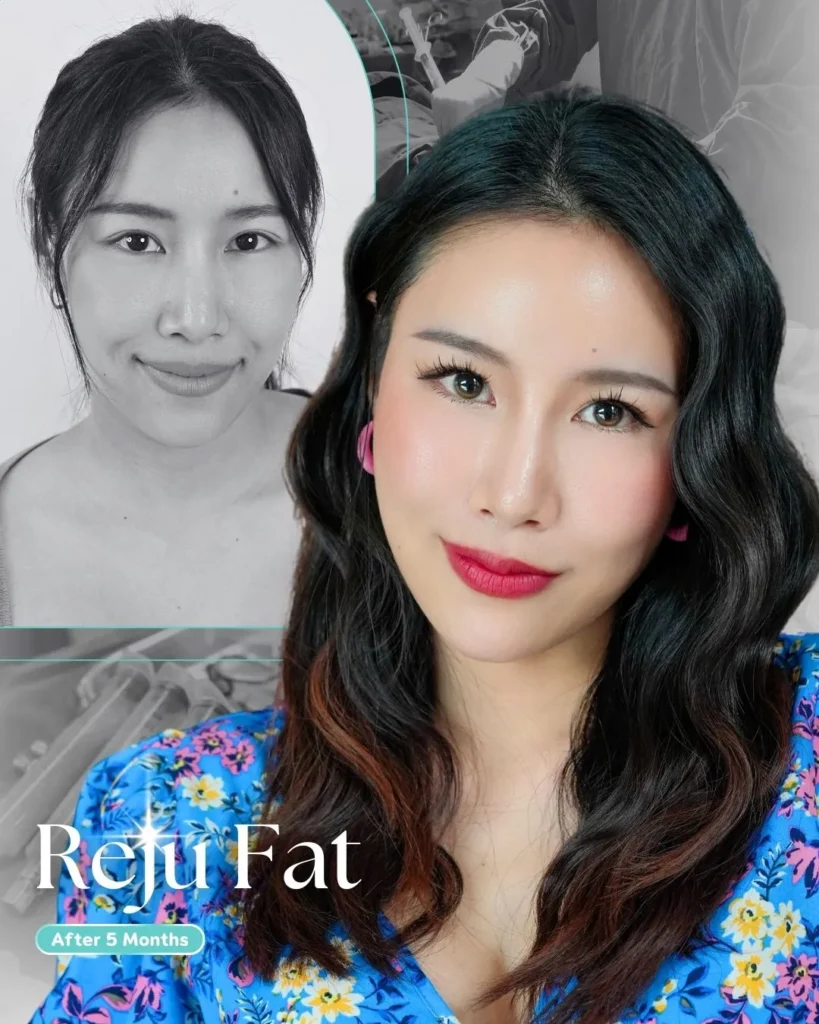

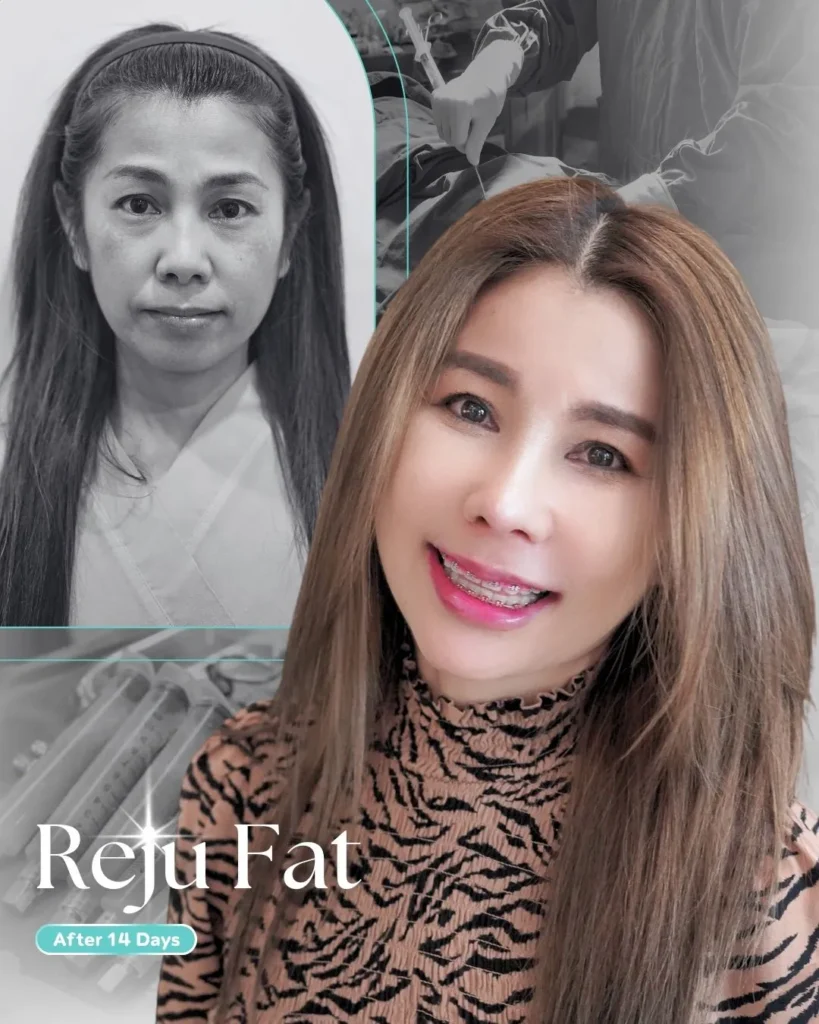


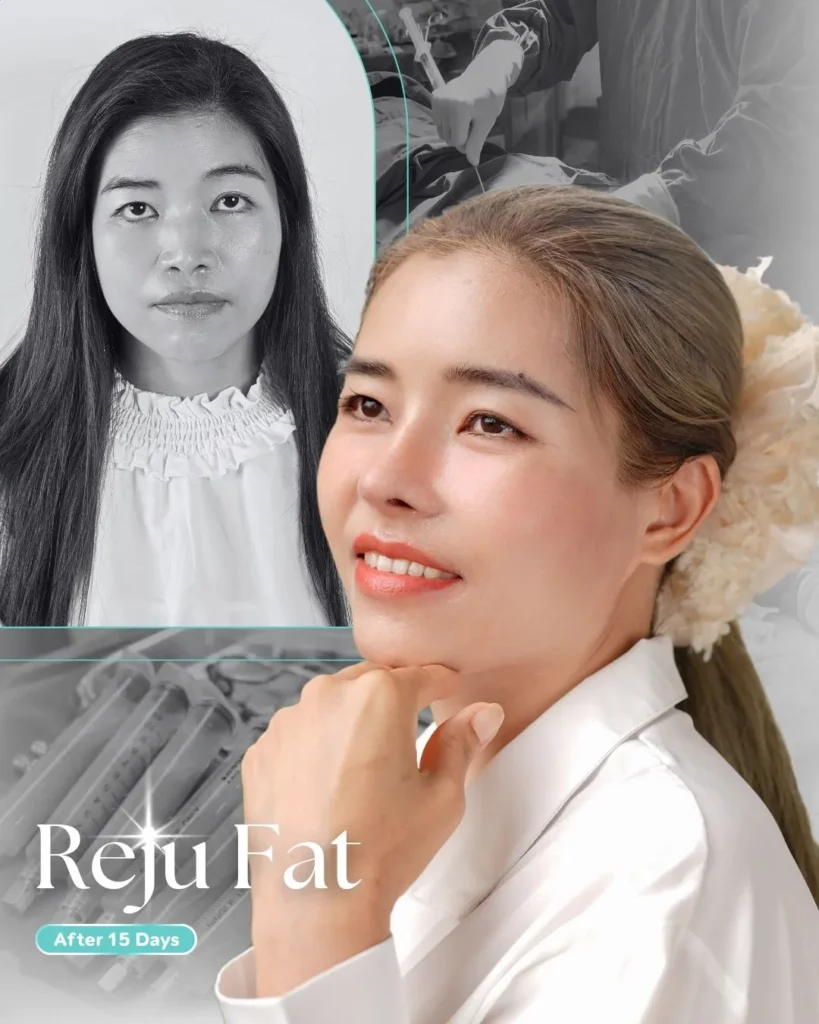
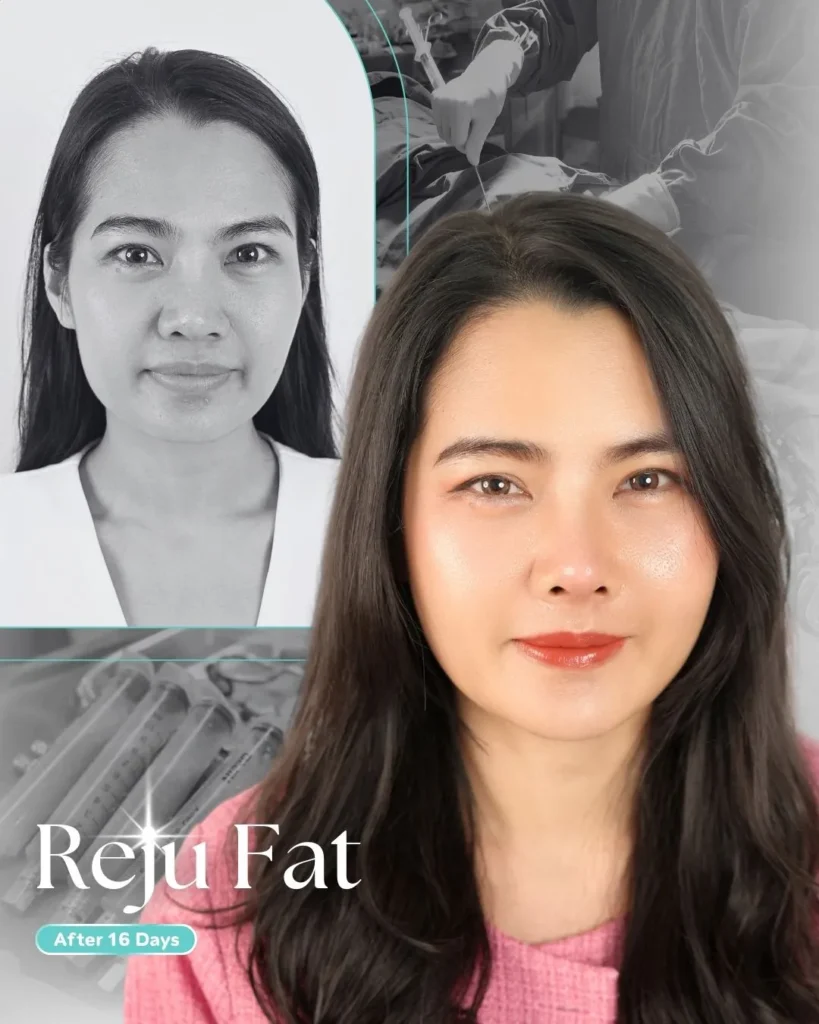


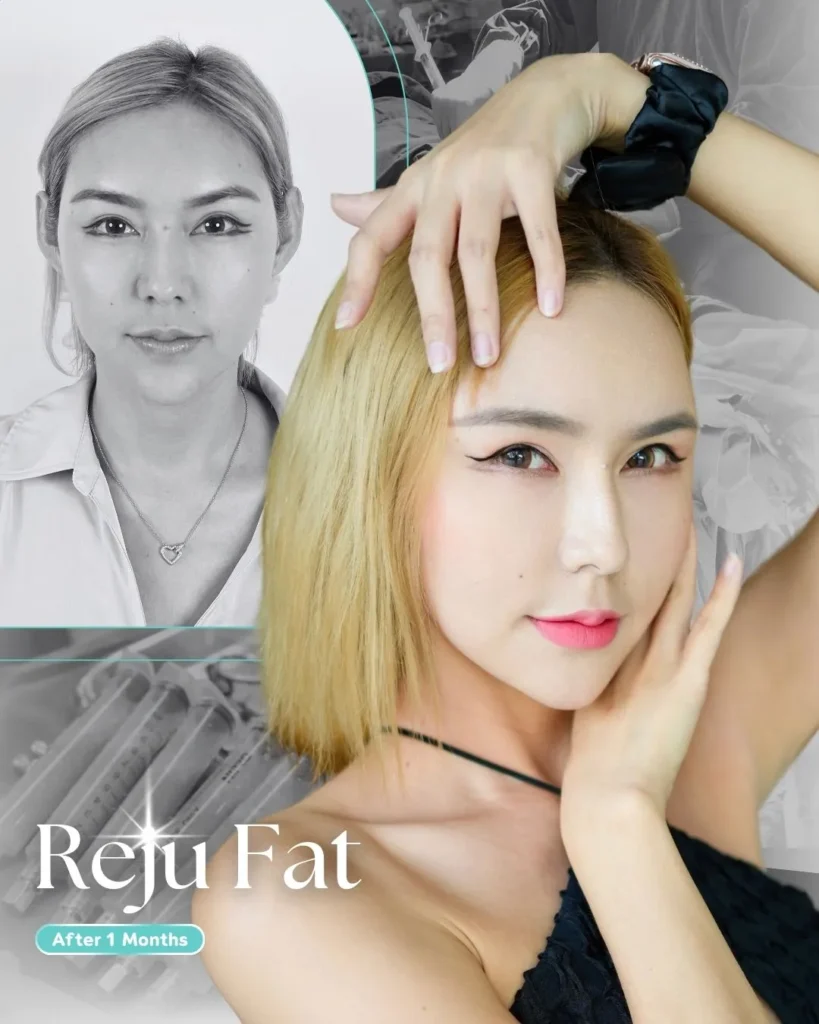

Scroll
down

Facial fat grafting involves transferring fat from unwanted areas, such as the thighs, abdomen, arms, back, etc., to correct deficiencies in certain facial areas. These include:
– Smile lines
– Under-eye bag
– Around the eyes
– Flat forehead
– Hollow temples
– Prominent cheekbones
Fat grafting is currently the best facial augmentation method because it uses natural fat from the patient’s own body, rather than synthetic substances, reducing the risk of allergic reactions and fluid retention in the injected areas.

Who Can Get Fat Grafting?
Anyone experiencing facial wrinkles can undergo the procedure from ages 20 to 75. As we age, the adhesion between the connective tissue and fat layers weakens in some areas, leading to wrinkles such as:
– Smile lines
– Tear troughs
– Forehead wrinkles
Some individuals also develop hollow cheeks due to fat loss in the cheek area.
Fat grafting is suitable for both men and women. From experience, Dr. Piyapol has observed that fat retention in men is even better than in women. Patients over 60 years old can still undergo this procedure, as there have been cases where fat grafting in older individuals had excellent long-term retention, comparable to younger patients.

Fat Grafting Techniques
The Growth Factors technique was pioneered by Dr. Piyapol in Thailand.
Unlike traditional methods, this advanced fat grafting technique involves extracting the fat then processing it through centrifugation then mixing it with Growth factor. This method improves fat retention by 3 times compared to the original techniques from 20 years ago. Traditionally, only 30% of injected fat would survive because fat is fragile and easily dissolves when transferred. However, with the Growth Factors technique, fat retention is as high as 80-90%, using a smaller amount of fat.
Comparison : Fillers vs Fat Grafting

Common Areas for Harvesting Fat

The best fat for facial grafting is typically extracted from: 1. Inner thighs 2.Outer thighs 3.Abdomen 4.Hips
Forehead
Forehead : For individuals with a flat forehead, fat grafting can create a fuller, smoother, and more dimensional appearance. It also enhances facial harmony and improves fortune-related aesthetics (Feng Shui beliefs). Additionally, fat grafting helps with deep wrinkle lines in the forehead area too.
Temples
Temples : For hollow or sunken temples, fat grafting smooths out the facial contour, making the face appear softer and less angular with less boldness on the cheekbone.
Under-Eyes
Under-Eyes : For those with deep tear troughs, dark circles, and fine lines, the face would looks older than the age. Causing difficulty to apply makeup on due to the powder falling into the deep lines which the makeup wouldn’t look smooth. Fat grafting would help the deep tear troughs to be more shallow and turn the dark circle to be more radiant making the eye looks youthful.
Smile lines
Smile lines : For deep smile lines running from the nose to the corners of the mouth, commonly found in older individuals that moves face muscle oftenly, fat grafting helps create a smoother, more youthful appearance.
Cheeks
Cheeks : For sunken cheeks that make the face look aged and tired, fat grafting restores volume, making the face look plumper and more youthful.
Eyelids
Eyelids : For hollow or deep-set upper eyelids, fat grafting can create a brighter, more youthful look.
@pmedclinic เสียงยืนยันจากสาวๆ 🫶🏻 หลังเติมไขมันหน้าเด็ก ปรับรูปหน้าให้ดูอ่อนเยาว์ ✨ #คุณหมอต้นปิยพล ด้วยเทคนิค Reju Fat + Growth Factor โดย #หมอต้นปิยพล เติมเต็มในจุดที่กังวล และยังมีประโยชน์ต่อสุขภาพผิว ลดริ้วรอยและฟื้นฟูความอ่อนเยาว์ได้อย่างมีประสิทธิภาพ บวมช้ำน้อยมาก ผิวหน้าอิ่มฟู เนียนละมุนเป็นธรรมชาติไม่เป็นก้อนเป็นคลื่น 🍃🌱 #เติมไขมันปรับรูปหน้า #เติมไขมันที่ไหนดี #เติมไขมันติดทนนาน #หมอต้นปิยพล #พีเมดคลินิก #pmedclinic ♬ เสียงต้นฉบับ - หมอต้นปิยพล Pmed Clinic
@pmedclinic เคยมีประสบการณ์ไม่ดีกับการเติมไขมันที่อื่นมา😭 ครั้งนี้กลับมาหาคุณหมอต้นอีกครั้ง ให้คุณหมอช่วยแก้ไขปัญหา ผ่านมาครบ4เดือน✨หน้าละมุนขึ้นมาก ไขมันยังติดดีอยู่ คนไข้ประทับใจในผลลัพธ์มาก และไม่ว่าจะอีกกี่ปีข้างหน้าก็ยังจะเลือกเติมไขมันกับคุณหมอต้นปิยพล ที่ PmedClinic🥰 #เติมไขมัน #เติมไขมันหน้า #เติมไขมันหน้าเด็ก ♬ Piano music(806606) - Draganov89
@pmedclinic ✨ มาไกลจาก เมกาเลยนะ ไม่สวยได้ไงงานนี้ กลับไปเพื่อนๆคงจำไม่ได้🥰 #เเก้จมูก #เติมไขมัน #ลดอายุ #พีเมดคลินิก #หมอต้น ♬ เสียงต้นฉบับ - Pmed Clinic - หมอต้นปิยพล Pmed Clinic
4 Step Fat Grafting Process at Pmed Clinic

Step 1 : Facial Analysis
Dr. Piyapol believes that a plastic surgeon must understand facial proportions to determine the best angle and fat grafting techniques approach for each patient.
He has undergone training in sculpture and painting as part of his specialized plastic surgery studies at Chulalongkorn Hospital, helping him understand beauty from an artistic perspective.He said that the skeleton on the face frame make the face dimension looks to hard and the soft part that is the fat would creat the dimension that creates the soft features of the face. As we age there is less fat causing hollow cheeks and hollow temples, which makes the face look too hard. So using fat grafting to fill up the hollows would be one way to solve this problem. However, it is up to the needs of the patient and the possibility of the face according to the doctor’s analysis. Still using a single method cannot be used to solve problems for all people.

Step 2 : Fat Extraction
This process takes about 15 minutes and requires 100-200 cc of fat or according to the doctor’s analysis. The fat would be calculated beforehand how much would it be needed and which part to harvest it from. Mostly fats are extracted from the thighs first if not enough the abdomen would be the next part. Most patients (85-90%) choose local anesthesia and would all say that Dr. Piyapol has a very gentle technique with minimal pain.Even during the extracting part the patient can still talk with the doctor as normal.

Step 3 : Fat Purification
Using the Growth Factors technique, Dr. Piyapol uses a special technique to separates and enhances the fat cells with Growth Factors extracted from the patient’s blood. This significantly improves fat survival, making it more stable and longer-lasting.

Step 4 : Fat Injection
In this steps, the doctor’s expertise is very important to know how much to inject in each position. The injection amount has to be precisely calculated with the understanding of when the fat would disappear too. Essentially, slight overcorrection is allowed but excessive fat injection is avoided. Too much fat can cause an unnatural look, and removing excess fat later is very difficult

นพ.ปิยพล พัฒนครู
ผู้ก่อตั้ง Pmed Clinic
Doctor’s Message
Fat grafting for a youthful face should be combined with Botox, a substance that causes temporary muscle paralysis. Most of the time, I’ll just spray it in one go. But there are some areas that are not conducive to fat grafting, such as the forehead. It’s like when you plant 100 trees on other land, 80 may grow, but if you plant them on the forehead, only 60 will grow. Therefore, we must see again whether the injection should be repeated or not. Usually, when fat is injected in areas that have a lot of movement, such as the forehead or cheeks. There will be a chance that fat deep lines will form because moving them will disturb the fat seedlings that we just planted. It’s still a young plant. If we disturb it, it might not stay in place. So I would also recommend Botox injections which are a substance that temporarily paralyzes the muscles.
Fat grafting or fat injection is like planting a tree. “Let us imagine that if we were to plant a tree, what would we need such as seedlings, soil, fertilizer, people planting the tree, etc. Seedlings are fat that we inject into the subcutaneous layer of the skin. Growth factors are fertilizer that we have developed techniques for almost 10 years until we have the best fertilizer formula. The soil is the body of the person receiving the service. How old are you? What gender are you? Do you get enough rest? Do you smoke? Are you drinking? Do you have a congenital disease, etc. We cannot fix this part, but we will do our best. Lastly, there are the people planting the tree. Which requires good technique and is highly experienced in this field due to each step of fat injection has complicated details. But it is not difficult because it can all be calculated in advance. If you have enough experience and care about it.
Why Choose Dr. Piyapol at Pmed Clinic?
Fat grafting not only does it create a completes the face to look younger but also help with the proportion of the face to look less aged in a more natural way. With a Growth factor that helps with rejuvenating the skin, it also helps with thick melasma, dark spots, and minimizing wrinkles.
Fat grafting is one of the option that patients choose to contour their face to be youthful because it helps filling in hallow spots and enhances the skin to be naturally healthy. That is why a lot have come out to approve that “Fat grafting has better value than filler.”
With fat grafting you can also get a longer result in a long run as long as 6 years or more. This makes fat grafting being the investment that is a better value in the long-term than filler because of its beauty and safety.
Pre & Post-Fat Grafting Care Instructions
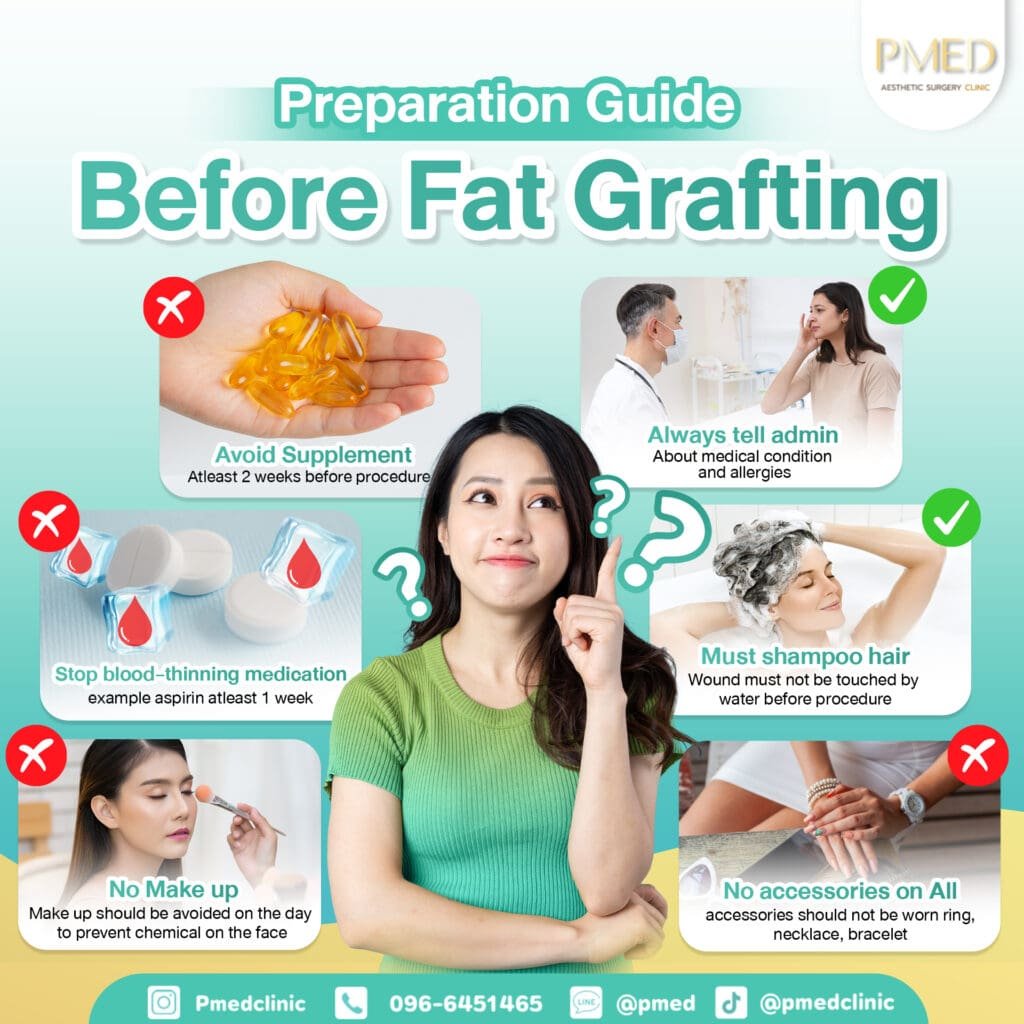
1. Consult a doctor to assess readiness :
Your doctor will check your overall health. This includes the location where liposuction is desired (such as the abdomen, thighs) and where the fat will be injected on the face. If you have a congenital disease or take regular medicine You should inform your doctor in detail.
2. Avoid certain medicines :
Stop using aspirin. Anti-inflammatory drugs (NSAIDs) and certain vitamins such as vitamin E or dietary supplements that may affect blood clotting, at least 1 week before the procedure
3. Abstain from cigarettes and alcohol :
Smoking and drinking alcohol may reduce the effectiveness of body fat attachment. You should abstain for at least 2 weeks before and after the procedure.
4. Get enough rest :
Adequate sleep helps the body recover and prepare for the surgical procedure.
5. Prepare comfortable clothes :
On the day of the procedure loose clothing is recommended for ease of movement after liposuction.

1. Avoid Pressure on the Injected Area :
Avoid pressing, massaging, or applying pressure on the injected areas. This includes avoiding sleeping on your side or stomach. Use a neck pillow or head support pillow to prevent fat from shifting.
2. Stay Hydrated :
Drinking enough water helps the injected fat survive and supports the body’s recovery process.
3. Avoid Intense Exercise :
Refrain from strenuous exercise or physically demanding activities for the first two weeks. If fat was extracted from the thighs or arms, wear compression garments as recommended by your doctor.
4. Avoid Extreme Heat or Cold : Do not expose the treated area to excessive heat or cold, as this can negatively affect fat retention.
5. Eat a Nutritious Diet : Increase consumption of protein and healthy fats, such as salmon, nuts, and avocados, to nourish the body and support fat cell survival. Avoid excessively salty foods, as they can cause prolonged facial swelling.
6. Monitor Progress and Follow-Up with Your Doctor :
Attend follow-up appointments as scheduled to assess results and address any potential concerns, such as abnormal redness, excessive swelling, or pain.
Fat grafting is an effective way to reshape and rejuvenate the face naturally. Following your doctor’s post-procedure care instructions can enhance fat retention and ensure optimal results. Key recommendations include avoiding pressure on the injected area, drinking enough water, avoiding intense exercise, and eating a nutrient-rich diet. Proper post-procedure care not only reduces risks but also promotes healthier skin and a well-balanced, youthful facial appearance in the long run.
Changes in the Face After Fat Grafting



1st Month
2nd Month
3rd Month
Swelling phase: This period involves water retention, as the newly transferred fat is still fragile and in the process of integrating into the fat layer. Swelling is common during this time.
Swelling reduction phase: The water retention gradually subsides, and the fat is still delicate. At first glance, it may appear as if the injected fat has disappeared, but in reality, some of the stronger fat cells have already attached to the existing fat layer.
Fat growth and stabilization phase: The fat settles into its final shape, fully integrating with the skin. With proper post-procedure care, the fat can remain in the face for many years, providing long-lasting volume and rejuvenation.
Duration of Bruise and Swelling
Changes in the Face After Fat Grafting

1st Month
Swelling phase : This period involves water retention, as the newly transferred fat is still fragile and in the process of integrating into the fat layer. Swelling is common during this time.

2nd Month
Swelling reduction phase : The water retention gradually subsides, and the fat is still delicate. At first glance, it may appear as if the injected fat has disappeared, but in reality, some of the stronger fat cells have already attached to the existing fat layer.

3rd Month
Fat growth and stabilization phase : The fat settles into its final shape, fully integrating with the skin. With proper post-procedure care, the fat can remain in the face for many years, providing long-lasting volume and rejuvenation.
Duration of Bruise and Swelling
Solve your doubts! What happens after fat injections to your face? Read this review before deciding.
6 Years After Fat Grafting—and Still Going!
One of the most common concerns for women after losing weight is a sunken face that appears older and tired. Facial fat grafting can effectively restore volume and youthfulness. In this case, even 6 years after the procedure, the fat remains well-retained, giving the face a fuller and more vibrant appearance.
Run-Down Face from Sunken Temples, Forehead & Cheeks
Concerns like hollow temples, forehead lines, nasolabial folds, and sunken cheeks can be corrected with facial fat grafting. After treatment, the entire face appears plumper, smoother, and more refreshed. The under-eye area also looks lifted and brighter. One added bonus—a dewy glow begins to appear as early as 1–2 months post-procedure, along with tighter pores. The result? Makeup goes on more easily, and the face looks noticeably younger and healthier.
Party Girl but the Fat Lasted for 6 Years
Another voice of satisfaction confirms the lasting results of facial fat grafting. This client underwent the procedure back in 2014, and even after six years, the fat remains well-retained. At the time, her main concerns were a tired appearance, hollow temples, deep under-eye areas, sunken cheeks, and pigmentation issues such as melasma and freckles. After receiving facial fat grafting, all of these concerns were effectively addressed. The treatment helped reduce wrinkles and long-standing dark spots, restoring a youthful, radiant look—so much so that people couldn’t help but compliment her refreshed appearance.
Party Girl but the Fat Lasted for 6 Years
In this case, the client had noticeable wrinkles, forehead lines, under-eye hollowness, and signs of fatigue due to aging. Facial fat grafting, combined with a nose enhancement in the same session, completely transformed her appearance. The results were so significant that people started complimenting her full, glowing face.
Before and After *
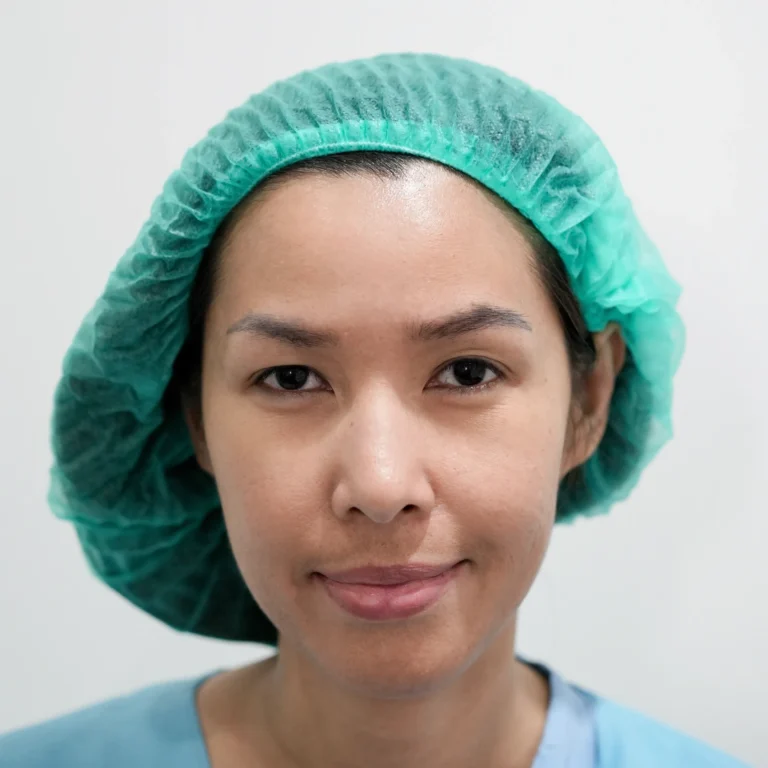






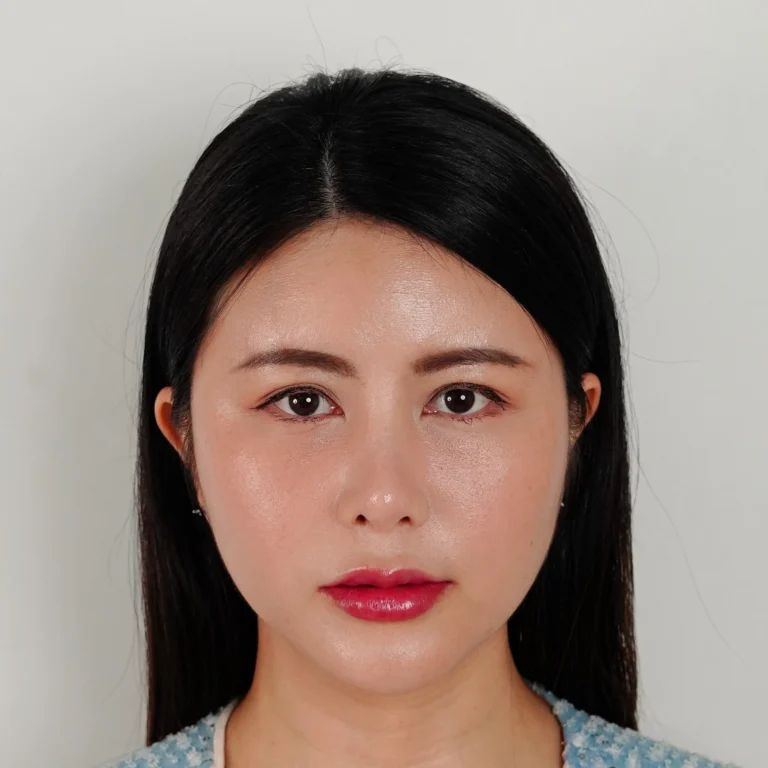








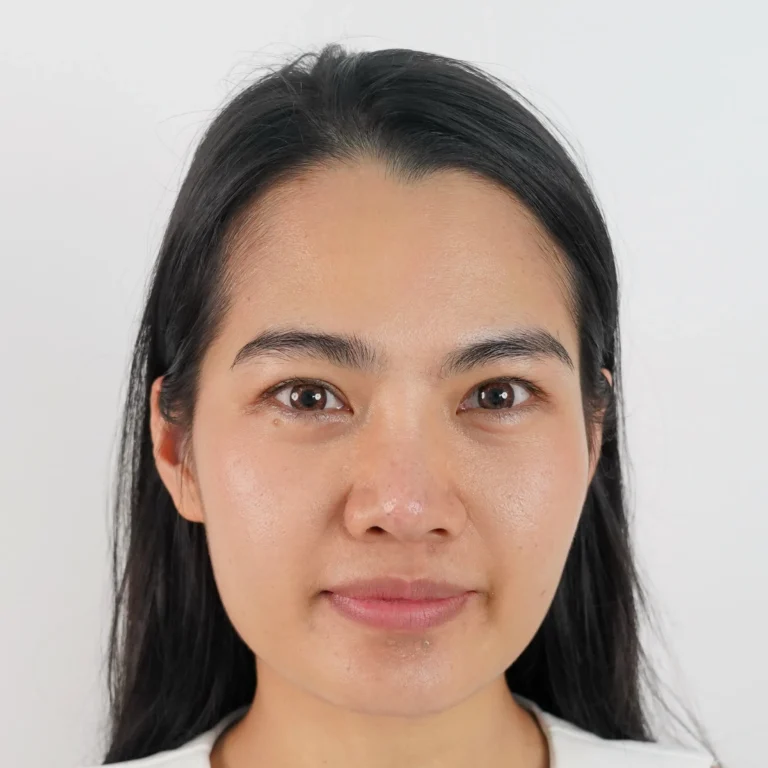



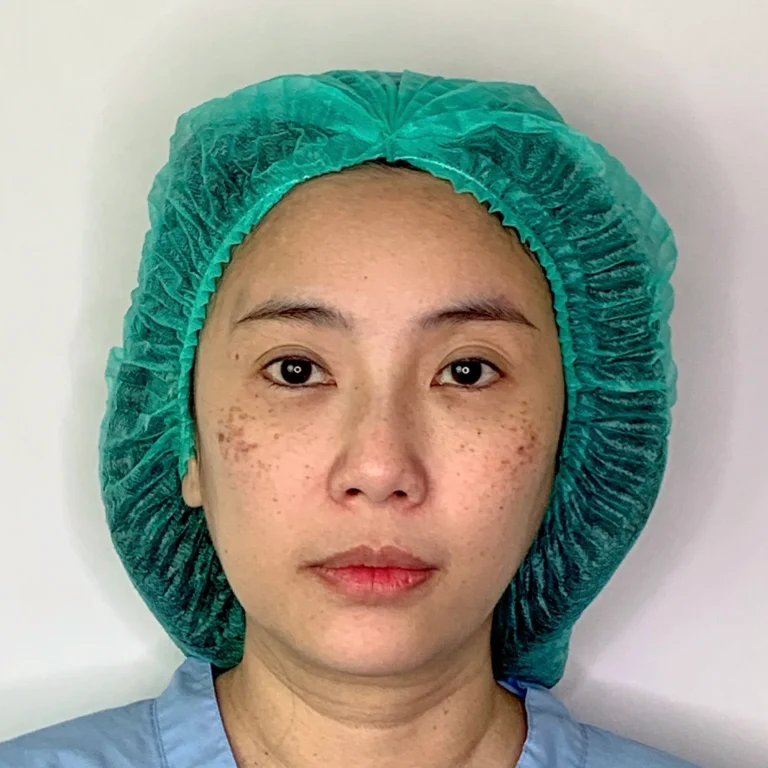

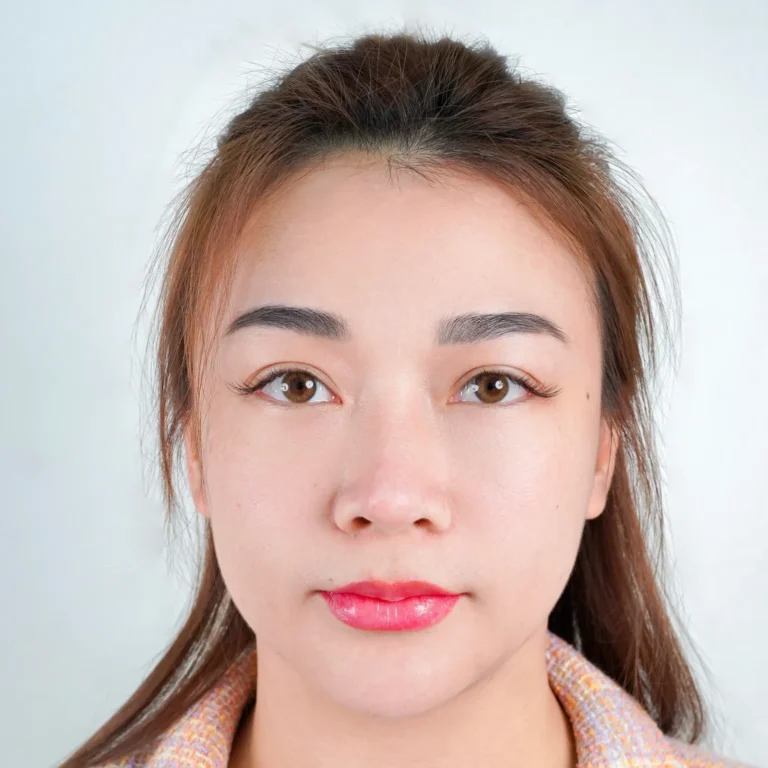

Book Consultation
FAQs
With Dr. Ton’s specialized technique at Pmed Clinic, fat grafts have a high survival rate of 70–80% and can last for many years.
However, the need for a second session depends on each patient’s preference. For those who prefer a consistently full look or enjoy a rounder facial contour, a touch-up session can be done later as desired.
Fat grafting results are typically long-lasting, averaging around 5 to 7 years.
That said, lifestyle factors such as frequent facial massages, heat exposure, lack of sleep, regular alcohol consumption, or natural aging can all affect fat retention over time.
Fat grafting rejuvenates the skin and stimulates collagen production in the deeper layers.
At Pmed Clinic, Dr. Ton enhances the treatment with a special technique using Growth Factors, derived from the patient’s own blood and processed using a highly concentrated separation system—three times stronger than standard PRP.
This advanced method improves fat survival by up to 20%, reduces post-treatment swelling, and significantly improves skin texture by:
- Reducing melasma and dark spots by 60–70% after just one session
- Visibly tightening pores
- Softening and smoothing the skin
Facial fat grafting uses the patient’s own fat to fill in hollows or deep grooves, resulting in a youthful, balanced, and contoured look. The face appears fuller, more dimensional, and naturally refreshed.

